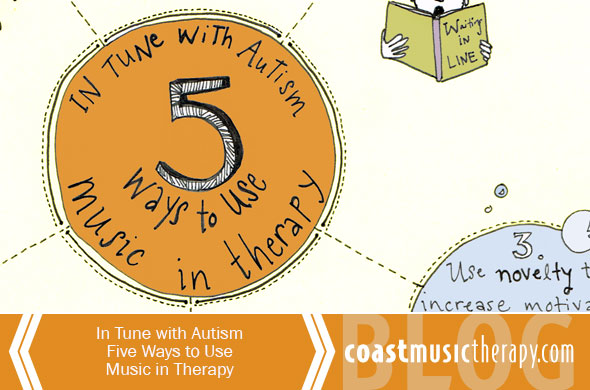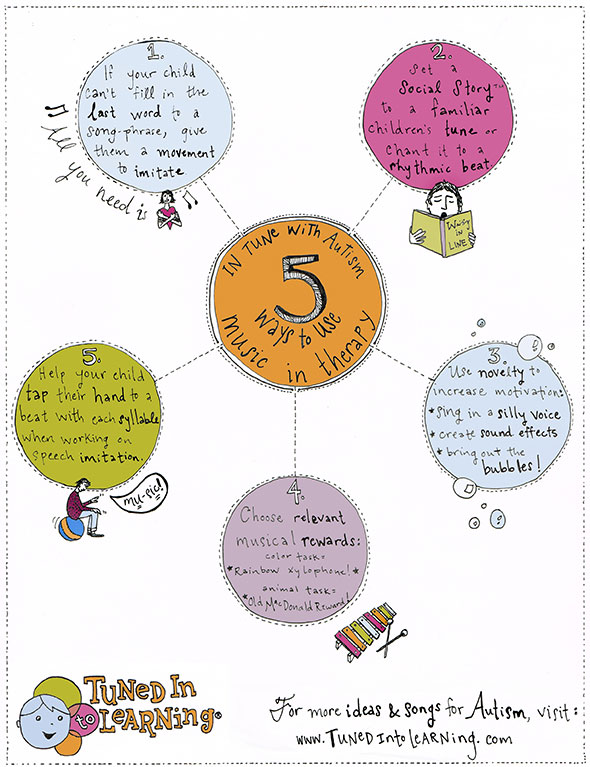
Autism Music Therapy Activities
Posted May 15th, 2013 by Coast Music Therapy
An autism music therapy infographic with five simple ways to use music at home or school.
Music is a great strength for so many children with autism! This full color illustrated tips page with autism music therapy activities can be printed or shared with teachers, speech therapists, music therapists, parents, and ABA providers.
How are autism and music connected?
It’s exciting to see the body of research relating to autism and music grow each year. This research lends support to what we do as music therapists and serves as a great reminder that individuals with autism DO have strengths and talents that can blossom through the years. Currently, the link between autism and musical processing has been the most well-researched topics within the realm of autism and music research.
Results have found that individuals, particularly those with high functioning autism demonstrate strengths in processing music and often show superior pitch processing compared to neurotypical peers. Other areas of research support the benefits of music and music therapy to assist in communication, social-emotional development, and behavior. Most recently, the use of auditory rhythmic cueing and Auditory-Motor Mapping Training are being explored as treatment approaches.
View our comprehensive music therapy autism research list here»»
Music Therapy Autism Activities
Music therapy provided by a Board Certified Music Therapist can be of benefit to many individuals with autism who show high interest and motivation for music. There are also simple ways you can incorporate music at home, school, or during other therapy sessions such as speech therapy, occupational therapy, or applied behavior analysis (ABA) therapy.
Here are five ways to use music in therapy, ideal for parents, family members, teachers, and therapists. The adorable artwork was created by talented illustrator Megan Gilbert for our sister company Tuned in to Learning®. Download and share in PDF format here or scroll to the bottom of this page to view a JPG version.
- If your child can’t fill in the last word to a song phrase, give them a movement to imitate instead. This will help make your child feel successful even if they are still learning to talk.
- Set a Social Story™ to a familiar children’s tune or chant it to a rhythmic beat. Melody and rhythm make the script easier to remember and can help add variety when reading the same story multiple times.
- Use novelty to increase motivation. For example, sing in a silly voice, create sound effects, or bring out the bubbles! This can be especially effective if your child appears fatigued or more difficult to engage during instruction.
- Choose relevant musical rewards! For example, if you are working on colors, allow your child to play a rainbow xylophone after identifying color flashcards, or sing “Old MacDonald” as a reward after your child completes an animal puzzle. Another way to approach musical rewards is to incorporate them within the task itself. Using this method, the child may actually identify colors on the xylophone itself rather than receiving the xylophone as a reward after identifying colors on flashcards. Embedding motivators into instruction is a common approach during Pivotal Response Treatment®, which is frequently used by ABA providers.
- Help your child tap their hand to a beat with each syllable when working on speech imitation. You can learn more about the research behind this approach here.
What other simple music strategies have you found to be helpful when teaching students with autism? Share with others by leaving a comment with your tip.
Add a Comment
You must be logged in to post a comment.















